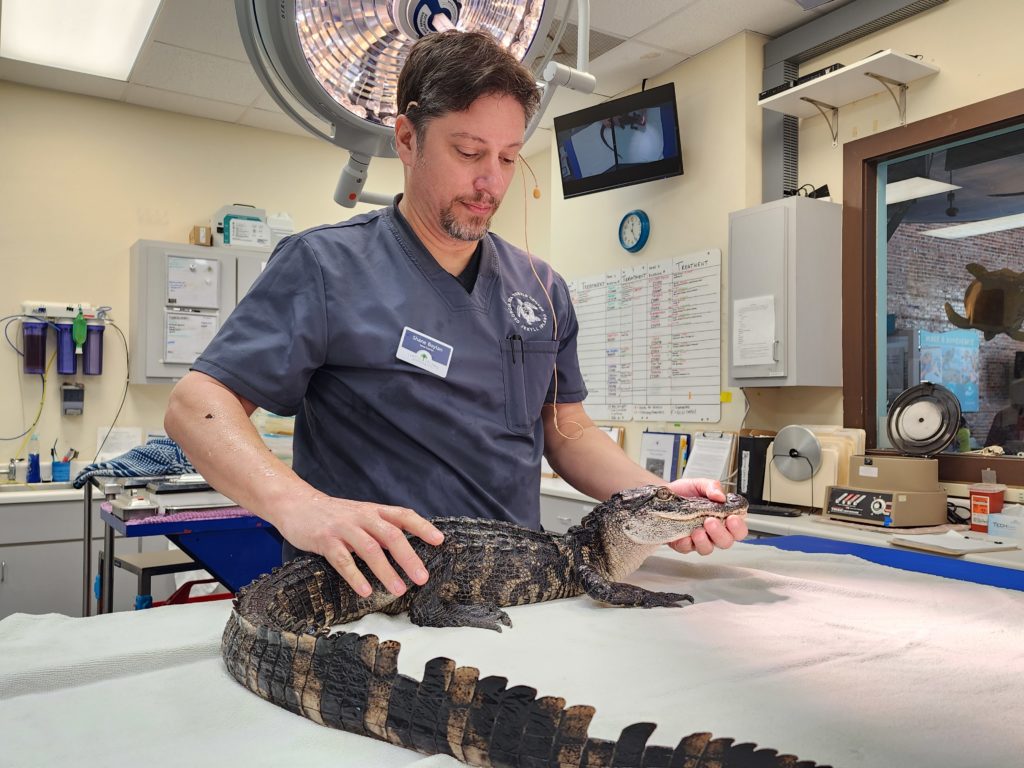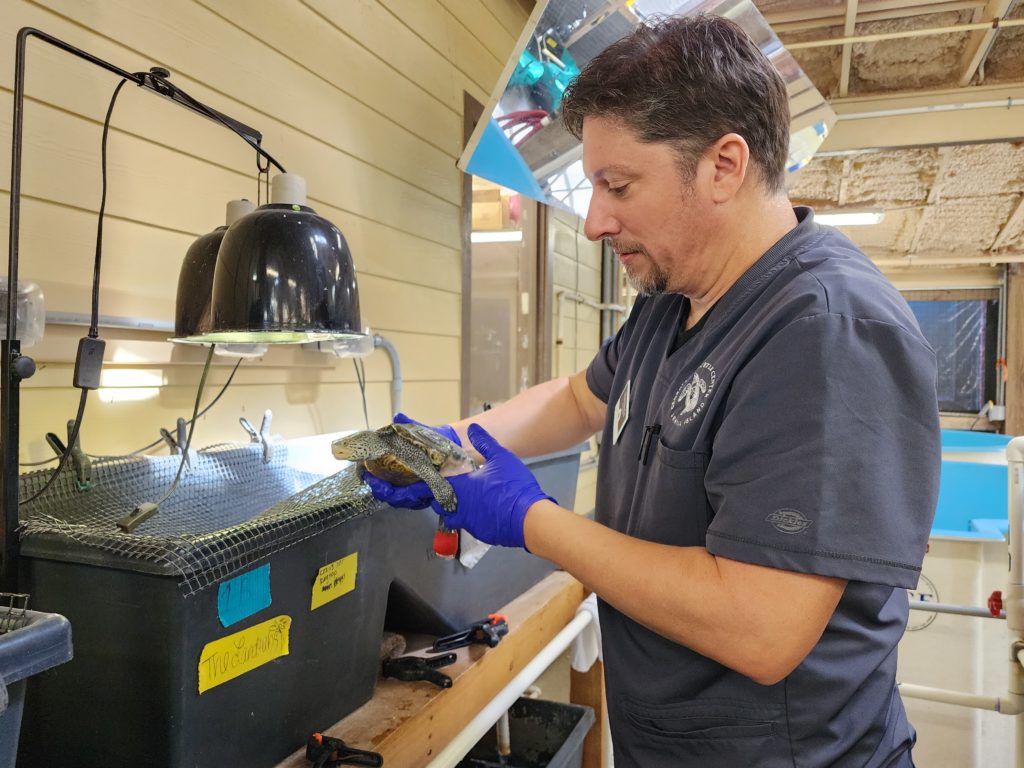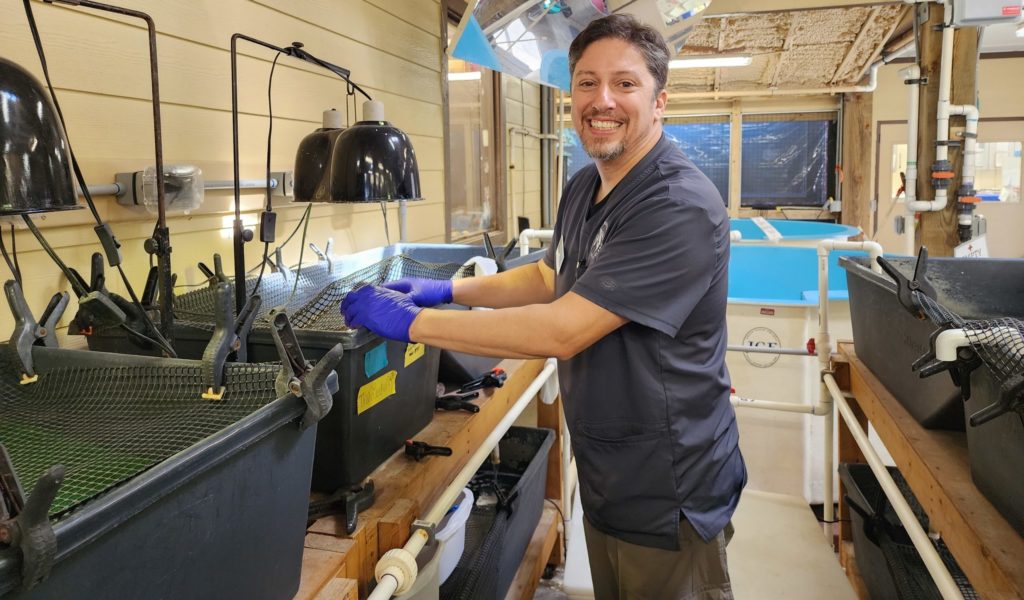with Shane Boylan, DVM, JIA’s Georgia Sea Turtle Center
When Shane Boylan says he was once part of the Turtle Team, he doesn’t mean he lived in a sewer system by day and was out fighting bad guys by night. The bad guy part, perhaps. But the fight has not been with a team of Ninja-trained shelled superheroes, or against pretend predators, but rather against the realities of beach litter and pollution, dangerous fishing nets, habitat erosion, and a myriad of ongoing threats and stressors to sensitive marine life.
Boylan fights the fight to save sea turtles and fellow marine life by day, and by night. As the new veterinarian at the Georgia Sea Turtle Center on Jekyll Island, Boylan took on the charge just this April, when fellow turtle-saving superhero and founder of the Center, Dr. Terry Norton retired.
Boylan, a graduate of North Carolina State CVM, recently sat down to chat in his few and far between minutes of free time, to talk about what brought him to Jekyll Island’s wildlife saving hub, and his current and future visions for the island’s unique sea turtle rescue haven.
Q: Can you briefly describe your background in the “sea turtle business”? This isn’t a position I would imagine comes around very often!
A: At NC State CVM (North Carolina State University College of Veterinary Medicine), they have a Turtle Team where students treat native (and some non-native) chelonids (a genus of turtles in the tortoise family, such as the Galapagos Giant Tortoise) as an extracurricular part of their veterinarian training. I intentionally went to NC State because I attended an open house as a high school student. I saw Mr. T, an injured box turtle, that was rehabbed together with screws and wire.
After I saw that, I knew I could help fix all those turtles on the side of the road. I spent the majority of my free time on the Turtle Team, and I was its president in my third year. I got to treat hundreds of turtles in my four years (we had more than 300 cases in one year alone). That kind of experience is unique. We had sea turtle specific lectures and several trips to The Karen Beasley Sea Turtle Rescue and Rehabilitation Center (in Surf City, NC). I also began working with the Turtle Survival Alliance in vet school. Twenty-plus years later, I still work with them. They have a breeding center near Charleston, where I was their vet for a number of years. I consult with them almost daily as part of their veterinary team. I’ve (completed) years of fieldwork with the Hicatee (Dermatemys mawaii) [white turtle] in Belize as part of the TSA. I helped to build the South Carolina Aquarium’s sea turtle program (during the past) 14 years. I’ve worked with South Carolina Department of Natural Resources (SCDNR), U.S. Fish and Wildlife Service (USFWS), and the National Oceanic and Atmospheric Administration (NOAA) on a variety of sea turtle projects including three different tours during the 2010 Deepwater Horizon Oil Spill. This led me to winning the South Carolina Department of Natural Resources Sea Turtle Rehabilitation Award in 2015.
I have experience with a very diverse group of Chelonians. I’ve treated one species that is extinct in the wild and has less than 50 members left alive in human care. I mention the diverse turtle experience because medicine from an Eastern box turtle (like a feeding tube, radiograph, impaction) directly translates to fixing sea turtles. I’ve been treating chelonids daily now for over two decades. Personally, I also have a few dozen chelonids that had health issues too complicated for anyone to tackle.
Q: The GSTC is a treasure for the Georgia coast. How did you first learn about the Center and what drew you to being a part of, and importantly, the new veterinarian of, it?
A: Dr. Norton is the living father of wildlife medicine, in particular sea turtles. Everyone knows about the GSTC because of him. I started at the South Carolina Aquarium in 2007, the same time Dr. Norton opened the GSTC. I came to the GSTC and patterned the AZA award winning sea turtle hospital on the GSTC concept.
Q: Prior to taking on this role, any sweet childhood turtle memories?
A: I have plenty of turtle stories. When it comes to sea turtle specific, I visited The Karen Beasley Sea Turtle Rescue and Rehabilitation Center as a child. Seeing all the injured sea turtles in tanks was an inspiration. Jean Beasly [mother of Karen Beasley] is a hero of mine; she was like the fairy grandmother of sea turtles. I’ve worked with her, and her sea turtles, for nearly two decades. Her commitment to their survival is unique.
Q: This sounds obvious and a bit silly, but why is protecting our sea turtle population important? Do most people realize this?
A: There is an intrinsic value in every species. If you remove sea turtles as a viable species, the damage to the ocean and beach ecologies would be catastrophic. From an emotional standpoint, the coastlines have value because we appreciate seeing the 40-year-old sea turtle female coming ashore to lay her eggs, and then we get to watch the nest hatch some 60 days later. The life history of sea turtles is a reminder of perseverance and the fragility of existence. Most people connect with the entire ocean when they learn of the life history of sea turtles.
Q: Dr. Norton was the leader of the Center from the start; what is it like filling his shoes?
A: He is the G.O.A.T. of sea turtle medicine and wildlife medicine in the U.S.! He taught many of my mentors, making him one the most experienced, practicing veterinarians in the world. It’s intimidating trying to fill the shoes of the Michael Jordan of wildlife medicine. Thankfully, we have taught shell repair labs together, and I’ve learned from him for two decades. He is always willing to help, and he’s a great resource.
Q: What are long term goals or plans you hope to achieve while at the Center?
A: I always try to improve veterinary medicine. I’ve been particularly successful in advancing medical science in fish and chelonids during my career. Part of that is getting the advanced technology put into practice. At the South Carolina Aquarium, our fundraising efforts were able to turn a med lab that was just a microscope in a closet to a full medical hospital with CT, ultrasound, radiography, surgery, stem cells and more. I hope we can continue to improve the GSTC in a similar fashion. I’d like to continue Dr. Norton’s vision and improve the medical care of sea turtles and local wildlife by improving the medicine here at GSTC. We need to add a CT machine to the GSTC’s onsite diagnostics because it’s critical in sea turtles with trauma, pneumonia and other serious conditions.
I have always enjoyed teaching, and I was recently recognized for teaching aquarium medicine and fish surgery for the past 5 years at the AquaVet program held every summer in Roger Williams University. I was the exotics speaker of the year in 2018 at the Veterinary Medical Expo. In the 1999-2000 school year at University of North Carolina at Chapel Hill, I won the Undergraduate Teaching Award and Access Award (for teaching students with disabilities). I’ve already been fortunate to give lectures and some labs since I’ve joined the GSTC, and I hope to find a way to finance further educational opportunities. This summer we had six wonderful veterinary student preceptors, and hopefully I can help build the educational capacity of the GSTC.
I’m also excited to expand the conservation impact of the GSTC to the wildlife on the island. We are already using the Center to help the JIA Conservation department’s work with alligators and diamondback rattlesnakes. I think my skill set can be used to help the management of the wildlife on the island including fish, invertebrates, birds, reptiles, amphibians, and mammals. I am excited to add to the research and conservation programs already in place on Jekyll Island. Our rehabilitation efforts with alligators have already discovered parasites and treatment options new to science in the first six months I have been here.
To support the work of Dr. Boylan and his team in rehabilitating sea turtles, click HERE. To learn more about the Georgia Sea Turtle Center, click HERE.




